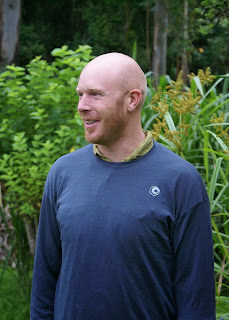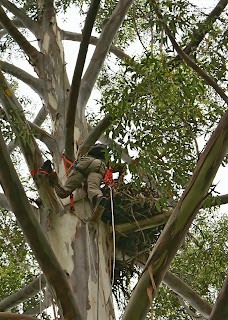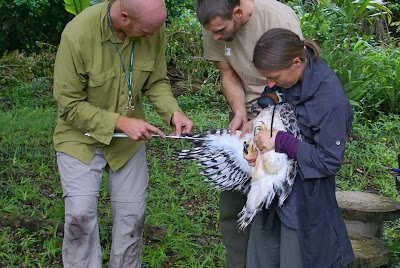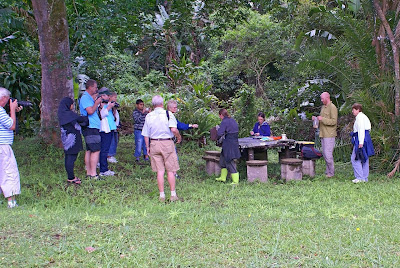Text & photos by Andy Ruffle (unless otherwise credited)
This morning’s
visit to watch a juvenile African Crowned Eagle being ringed, by Shane
McPherson, was certainly one of those once in a lifetime experiences.
 |
| Shane McPherson |
Shane, an MSc
student from UKZN’s School of Life Sciences in Pietermaritzburg, is undertaking
research to determine why Crowned Eagles appear to be doing so well in the
urban open spaces around Durban. His research project is titled, the
‘Breeding Ecology of Peri-urban Crowned Eagles (Stephanoaetus coronatus)
in KwaZulu-Natal.’
Eileen Brannigan, Doug Butcher, Janet Dalton, Margaret Jones, Andrew Pickles, Andy Ruffle, Jacques Sellschop and Irma Smook, met up
with Shane and his three assistants at 0700. He gave us a 'brief' on his
project, with some eye opening information about the breeding habits of this sometimes misunderstood bird.
It is often perceived that these eagles prey on small domestics pets, but Shane's research, so far, actually disproves this belief. Although a cat has been observed being brought to a nest, the percentage is extremely low. Dassies are the predominant food source.
 |
| Shane gives us some insight into his research |
Shane and his team then set about the gruelling task of retrieving the chick from the nest, located some 30m or more up in a gum tree.
 |
| ''high climb to retrieval'' |
 |
| Fishing for eagles |
Firstly, a weighted line was cast over
a high branch, using a fishing rod (photo above left). The climbing rope was then attached to the end of the fishing line and hoisted up and over the branch. Once the line was safely secured, Shane 'kitted up' and commenced his ascent to the nest.
 |
| 'Kitted up' and ready to go |
 |
| Up, up and away |
On reaching the nest, Shane carefully maneuvered to retrieve the chick and placed it in a bag to be lowered down to the team waiting below.
 |
| Shane retrieves the chick |
 |
| and lowers it in a bag |
With our chick safely on the ground, the important data collection and ringing process began.
 |
| Tomas takes the chick to the work station |
 |
| The chick is prepped for the data collection |
 |
| Not very attractive, but the hood keeps the chick calm |
 |
| Shane fits the metal ring on the left leg |
Shane quickly identified the chick as a female, from the size of her feet.
A metal numbered ring was placed on the left leg, followed by a yellow plastic numbered ring on the right leg. The plastic ring has the number T1, which Shane says indicates Trogons 1.
Beak, head, tail and wing measurements were then taken.
A small sample of blood was drawn for analysis.
Finally she was weighed, coming in at 3.115kg.
After a short spell to allow her to stretch her wings, she was promptly returned to the nest.
 |
| A yellow plastic ring T1 for Trogons 1 for the right leg |
 |
| Shane takes beak measurements |
 |
| Measuring the head |
 |
| The tail feathers only develop properly once the bird can fly |
 |
| Beautiful under wing pattern |
 |
| Small blood sample being drawn |
 |
| Weighing the chick (priceless/kg) |
'Trogons 1' is estimated to be about 75 days old, which means she will probably leave the nest in another 30 days or so. Please be on the lookout for her with her trendy yellow bracelet. If you do see her, we ask that you note the day, time and precise location if possible. You can either contact Andy (andy_ruffle@yahoo.co.uk) or Shane (shane.mcpherson@gmail.com).
If you are able to take a photo, even better.
Shane is also interested in any other nests in our area, so please do let us know.
Shane is also interested in any other nests in our area, so please do let us know.
We can't thank Shane enough for the work he is doing and giving us the opportunity to experience such a magnificent bird at close range.
To learn more about Shane's project click here.


Andy thanks for this am . Most interesting and I'm so glad that I was able to attend . I am in awe of the effort that people put into conservation projects . And in their knowledge and keenness in trying to create awareness of all creatures wild and wonderful . A special morning . Margaret Jones
ReplyDeleteit really was a life time experience!
ReplyDeleteNoeleen Phillips
oh so jealous that I could not be there! Delighted that the day went so well.
ReplyDeleteLennart and Evelyn